Haoyin Zhou
Real-time Nonrigid Mosaicking of Laparoscopy Images
Mar 12, 2021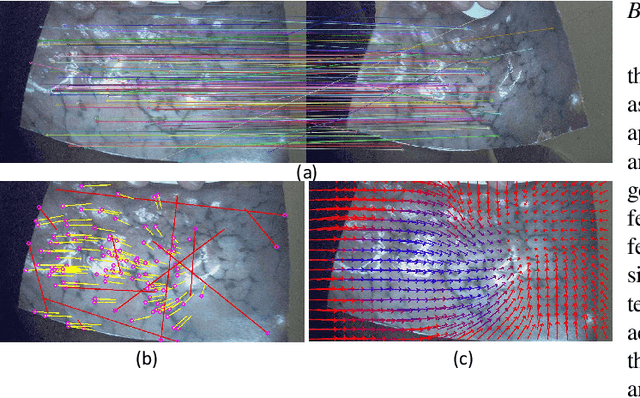


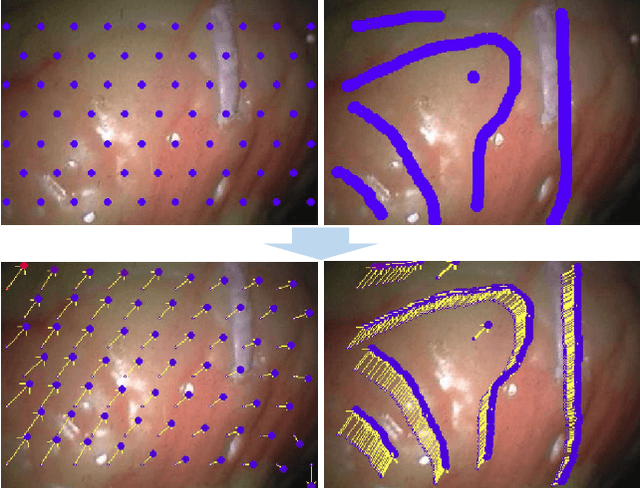
Abstract:The ability to extend the field of view of laparoscopy images can help the surgeons to obtain a better understanding of the anatomical context. However, due to tissue deformation, complex camera motion and significant three-dimensional (3D) anatomical surface, image pixels may have non-rigid deformation and traditional mosaicking methods cannot work robustly for laparoscopy images in real-time. To solve this problem, a novel two-dimensional (2D) non-rigid simultaneous localization and mapping (SLAM) system is proposed in this paper, which is able to compensate for the deformation of pixels and perform image mosaicking in real-time. The key algorithm of this 2D non-rigid SLAM system is the expectation maximization and dual quaternion (EMDQ) algorithm, which can generate smooth and dense deformation field from sparse and noisy image feature matches in real-time. An uncertainty-based loop closing method has been proposed to reduce the accumulative errors. To achieve real-time performance, both CPU and GPU parallel computation technologies are used for dense mosaicking of all pixels. Experimental results on \textit{in vivo} and synthetic data demonstrate the feasibility and accuracy of our non-rigid mosaicking method.
Re-weighting and 1-Point RANSAC-Based PnP Solution to Handle Outliers
Jul 16, 2020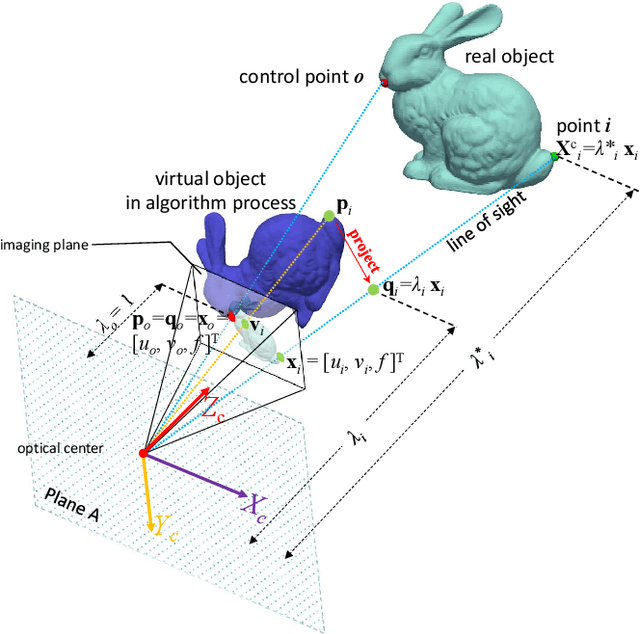
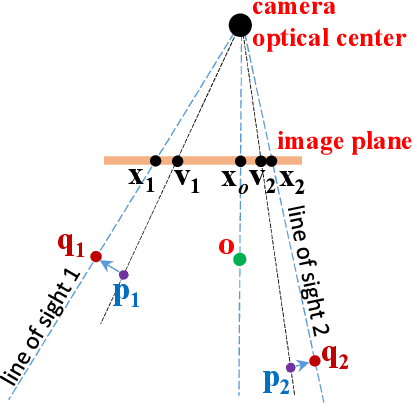
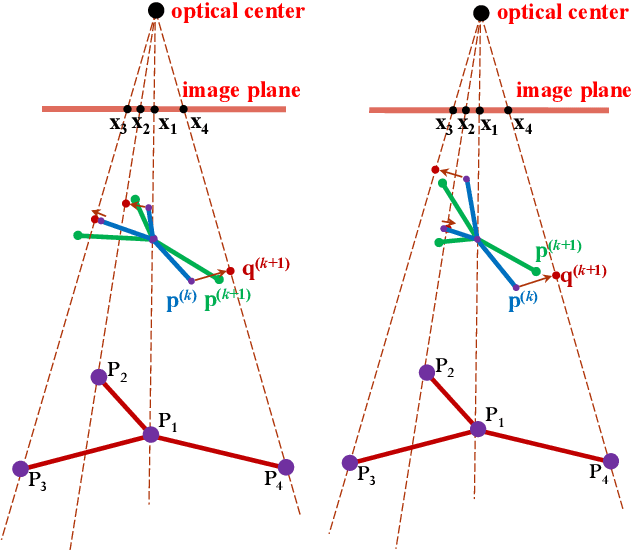
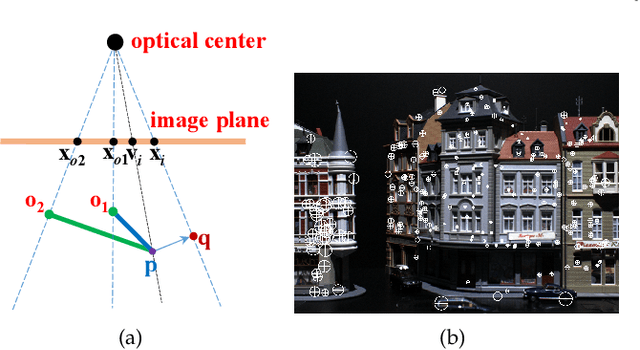
Abstract:The ability to handle outliers is essential for performing the perspective-n-point (PnP) approach in practical applications, but conventional RANSAC+P3P or P4P methods have high time complexities. We propose a fast PnP solution named R1PPnP to handle outliers by utilizing a soft re-weighting mechanism and the 1-point RANSAC scheme. We first present a PnP algorithm, which serves as the core of R1PPnP, for solving the PnP problem in outlier-free situations. The core algorithm is an optimal process minimizing an objective function conducted with a random control point. Then, to reduce the impact of outliers, we propose a reprojection error-based re-weighting method and integrate it into the core algorithm. Finally, we employ the 1-point RANSAC scheme to try different control points. Experiments with synthetic and real-world data demonstrate that R1PPnP is faster than RANSAC+P3P or P4P methods especially when the percentage of outliers is large, and is accurate. Besides, comparisons with outlier-free synthetic data show that R1PPnP is among the most accurate and fast PnP solutions, which usually serve as the final refinement step of RANSAC+P3P or P4P. Compared with REPPnP, which is the state-of-the-art PnP algorithm with an explicit outliers-handling mechanism, R1PPnP is slower but does not suffer from the percentage of outliers limitation as REPPnP.
* https://github.com/haoyinzhou/PnP_Toolbox
Real-time Surface Deformation Recovery from Stereo Videos
Jul 16, 2020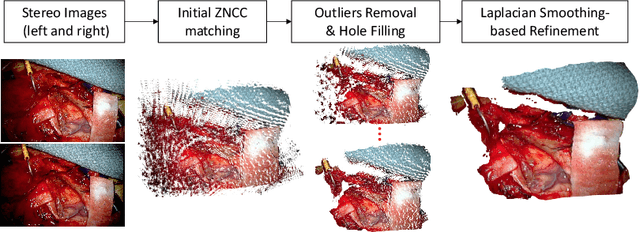

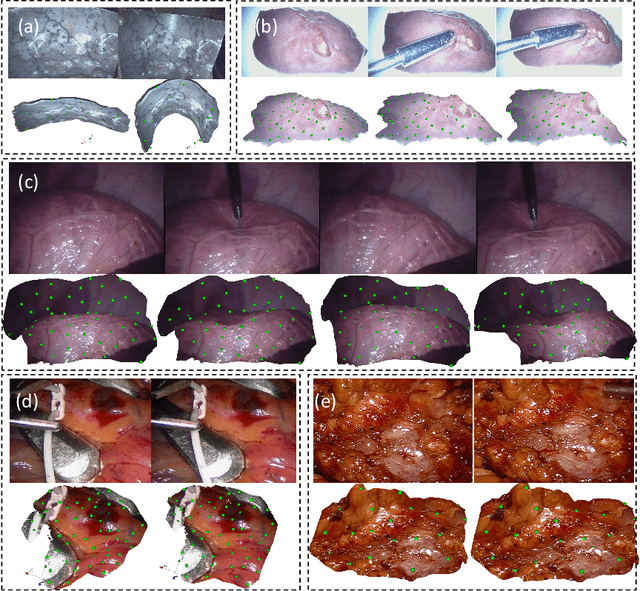
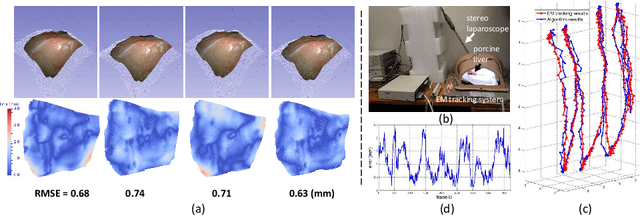
Abstract:Tissue deformation during the surgery may significantly decrease the accuracy of surgical navigation systems. In this paper, we propose an approach to estimate the deformation of tissue surface from stereo videos in real-time, which is capable of handling occlusion, smooth surface and fast deformation. We first use a stereo matching method to extract depth information from stereo video frames and generate the tissue template, and then estimate the deformation of the obtained template by minimizing ICP, ORB feature matching and as-rigid-as-possible (ARAP) costs. The main novelties are twofold: (1) Due to non-rigid deformation, feature matching outliers are difficult to be removed by traditional RANSAC methods; therefore we propose a novel 1-point RANSAC and reweighting method to preselect matching inliers, which handles smooth surfaces and fast deformations. (2) We propose a novel ARAP cost function based on dense connections between the control points to achieve better smoothing performance with limited number of iterations. Algorithms are designed and implemented for GPU parallel computing. Experiments on ex- and in vivo data showed that this approach works at an update rate of 15Hz with an accuracy of less than 2.5 mm on a NVIDIA Titan X GPU.
Real-time Dense Reconstruction of Tissue Surface from Stereo Optical Video
Jul 16, 2020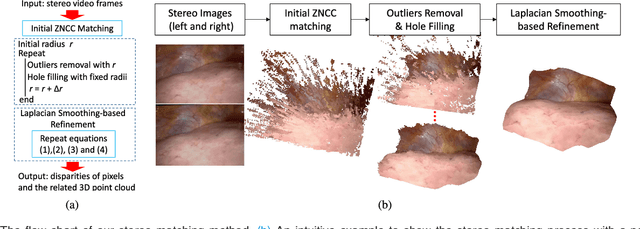
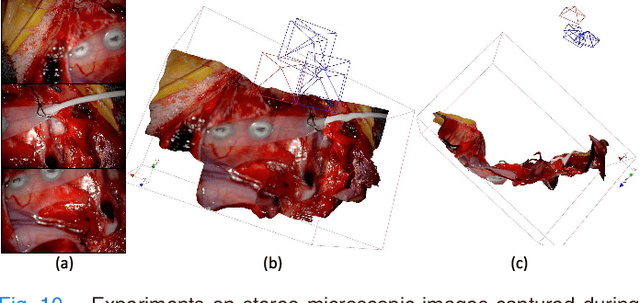
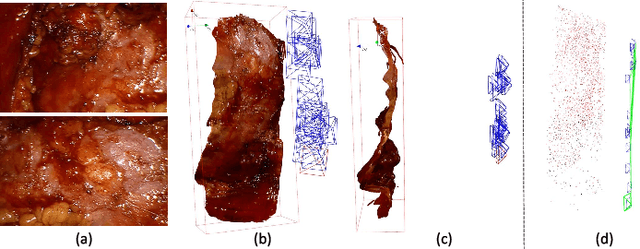
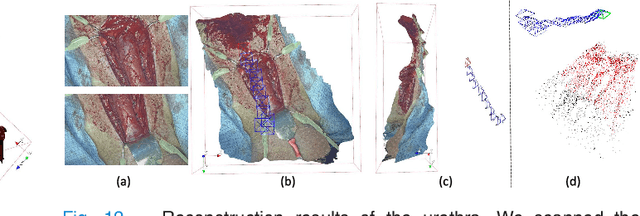
Abstract:We propose an approach to reconstruct dense three-dimensional (3D) model of tissue surface from stereo optical videos in real-time, the basic idea of which is to first extract 3D information from video frames by using stereo matching, and then to mosaic the reconstructed 3D models. To handle the common low texture regions on tissue surfaces, we propose effective post-processing steps for the local stereo matching method to enlarge the radius of constraint, which include outliers removal, hole filling and smoothing. Since the tissue models obtained by stereo matching are limited to the field of view of the imaging modality, we propose a model mosaicking method by using a novel feature-based simultaneously localization and mapping (SLAM) method to align the models. Low texture regions and the varying illumination condition may lead to a large percentage of feature matching outliers. To solve this problem, we propose several algorithms to improve the robustness of SLAM, which mainly include (1) a histogram voting-based method to roughly select possible inliers from the feature matching results, (2) a novel 1-point RANSAC-based P$n$P algorithm called as DynamicR1PP$n$P to track the camera motion and (3) a GPU-based iterative closest points (ICP) and bundle adjustment (BA) method to refine the camera motion estimation results. Experimental results on ex- and in vivo data showed that the reconstructed 3D models have high resolution texture with an accuracy error of less than 2 mm. Most algorithms are highly parallelized for GPU computation, and the average runtime for processing one key frame is 76.3 ms on stereo images with 960x540 resolution.
Smooth Deformation Field-based Mismatch Removal in Real-time
Jul 16, 2020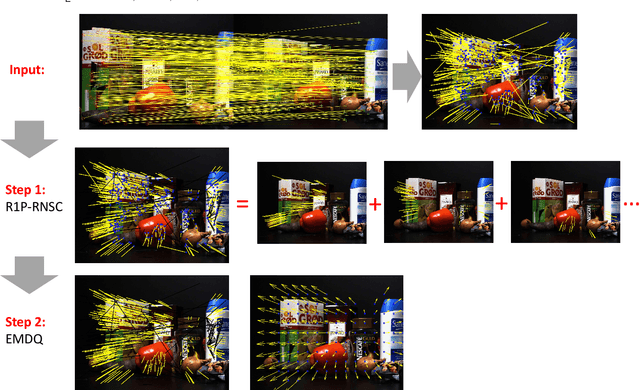

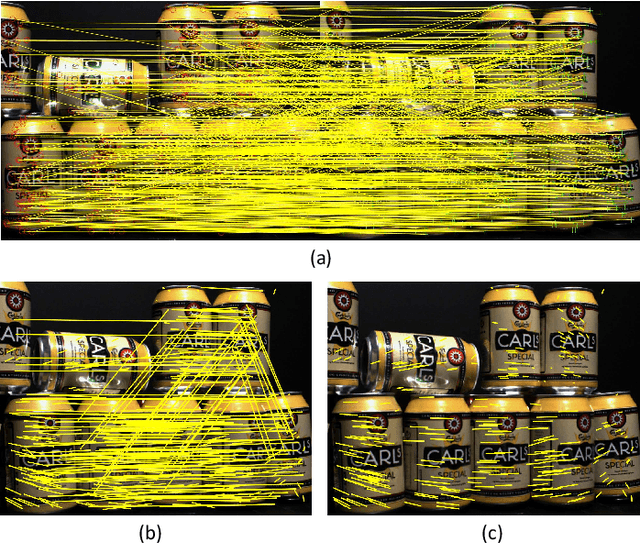
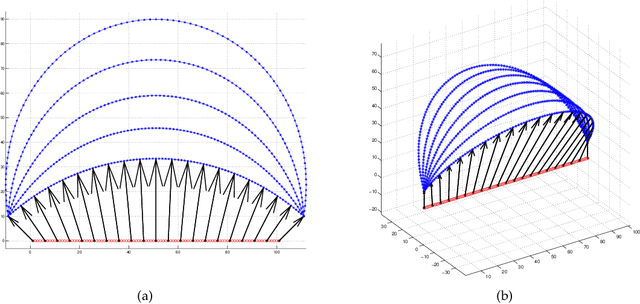
Abstract:This paper studies the mismatch removal problem, which may serve as the subsequent step of feature matching. Non-rigid deformation makes it difficult to remove mismatches because no parametric transformation can be found. To solve this problem, we first propose an algorithm based on the re-weighting and 1-point RANSAC strategy (R1P-RNSC), which is a parametric method under a reasonable assumption that the non-rigid deformation can be approximately represented by multiple locally rigid transformations. R1P-RNSC is fast but suffers from a drawback that the local smoothing information cannot be taken into account. Then, we propose a non-parametric algorithm based on the expectation maximization algorithm and dual quaternion (EMDQ) representation to generate the smooth deformation field. The two algorithms compensate for the drawbacks of each other. Specifically, EMDQ needs good initial values provided by R1P-RNSC, and R1P-RNSC needs EMDQ for refinement. Experimental results with real-world data demonstrate that the combination of the two algorithms has the best accuracy compared to other state-of-the-art methods, which can handle up to 85% of outliers in real-time. The ability to generate dense deformation field from sparse matches with outliers in real-time makes the proposed algorithms have many potential applications, such as non-rigid registration and SLAM.
Implicit Tubular Surface Generation Guided by Centerline
Jun 09, 2016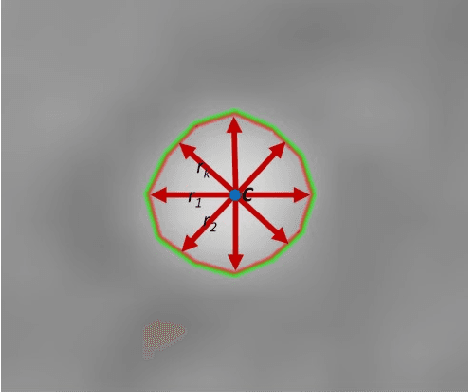

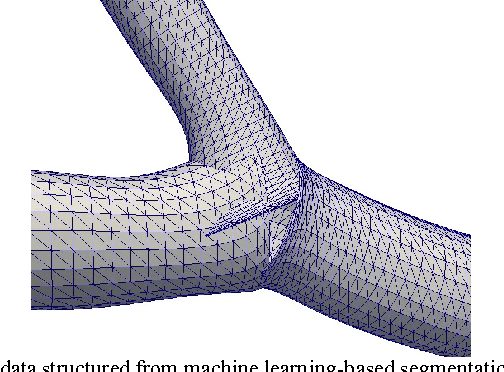
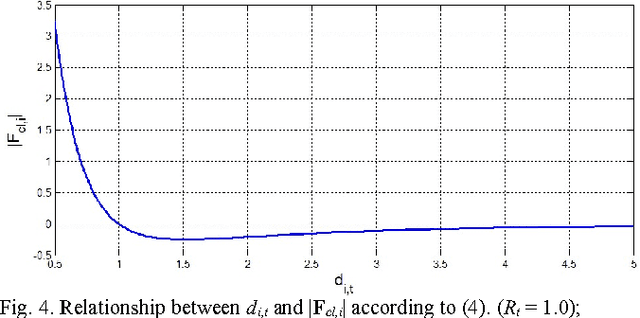
Abstract:Most machine learning-based coronary artery segmentation methods represent the vascular lumen surface in an implicit way by the centerline and the associated lumen radii, which makes the subsequent modeling process to generate a whole piece of watertight coronary artery tree model difficult. To solve this problem, in this paper, we propose a modeling method with the learning-based segmentation results by (1) considering mesh vertices as physical particles and using interaction force model and particle expansion model to generate uniformly distributed point cloud on the implicit lumen surface and; (2) doing incremental Delaunay-based triangulation. Our method has the advantage of being able to consider the complex shape of the coronary artery tree as a whole piece; hence no extra stitching or intersection removal algorithm is needed to generate a watertight model. Experiment results demonstrate that our method is capable of generating high quality mesh model which is highly consistent with the given implicit vascular lumen surface, with an average error of 0.08 mm.
Fast Segmentation of Left Ventricle in CT Images by Explicit Shape Regression using Random Pixel Difference Features
Jul 28, 2015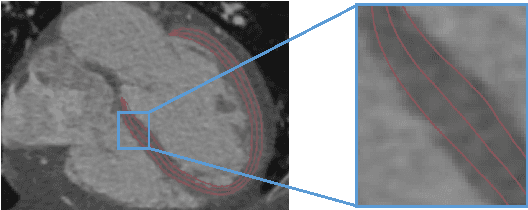

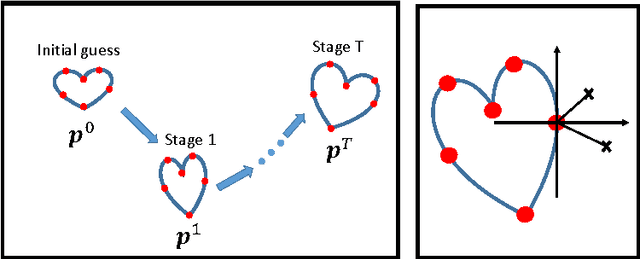

Abstract:Recently, machine learning has been successfully applied to model-based left ventricle (LV) segmentation. The general framework involves two stages, which starts with LV localization and is followed by boundary delineation. Both are driven by supervised learning techniques. When compared to previous non-learning-based methods, several advantages have been shown, including full automation and improved accuracy. However, the speed is still slow, in the order of several seconds, for applications involving a large number of cases or case loads requiring real-time performance. In this paper, we propose a fast LV segmentation algorithm by joint localization and boundary delineation via training explicit shape regressor with random pixel difference features. Tested on 3D cardiac computed tomography (CT) image volumes, the average running time of the proposed algorithm is 1.2 milliseconds per case. On a dataset consisting of 139 CT volumes, a 5-fold cross validation shows the segmentation error is $1.21 \pm 0.11$ for LV endocardium and $1.23 \pm 0.11$ millimeters for epicardium. Compared with previous work, the proposed method is more stable (lower standard deviation) without significant compromise to the accuracy.
 Add to Chrome
Add to Chrome Add to Firefox
Add to Firefox Add to Edge
Add to Edge